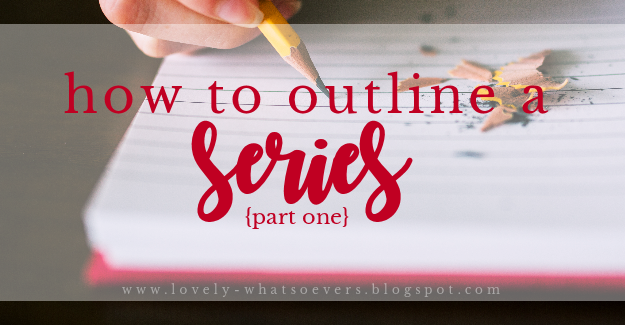How to Outline a Series {Part One}
Some stories need more than one installment to tell. Sometimes, that’s the author’s decision from the beginning. And other times…those stories inform us there’s more to be told! While I don’t always outline my writing projects, I thought it would be fun to take a look at how I approach writing series when I outline them.
So in this blog post, I’ll be talking about planned series! There’s no set rule for how long a series should be, but since trilogies are the most common, that’s the example I’ll be using.
The Idea:
My story ideas usually start with the characters or a scene, and I build from there. If I’m planning a series, I like to know a few things by the time I’ve started drafting the first book:
What is the main plot thread? How many installments do I want to write? What are the main events of each installment and how are they connected through the main plot thread? What are the characters up against?
(Even if I’m in the middle of drafting the first book when I realize it could be a series, I can still ask these questions and discover the answers as I go along.)
With those answers, I can start building the series outlines! I usually break the series overview down like this:
Book One:
- Main events:
- What are they?
- In what order do they occur?
- Characters:
- What is their normal?
- Goals/obstacles
- Foreshadowing:
- Subtle hints to events later in first book (and/or later books)
- Story threads:
- Series: How will series plot show through in this book’s plot points, character arcs, etc.?
- Book: Close individual story line(s).
- [Loose ends: Not every story thread must be tied up neatly within the first book. Some subplots can be left open to continue in later installments.]
Book Two:
- Main events:
- What are they?
- Order of occurrence?
- How are they influenced by the first book’s events?
- How do they fit into the plot of the series?
- Characters:
- How have they changed from first installment?
- How does that affect their goals?
- Foreshadowing:
- Hints to events in book/later installments
- Story threads:
- Series: How does series plot continue in this installment’s events, characters, etc.?
- Book: Close individual storylines. Close some of the subplots from first installment as well.
Book Three:
- Main events:
- What are they?
- Order of occurrence?
- How do previous events affect them?
- Characters:
- What are they like now?
- Have their goals changed?
- Story threads:
- Series: Close main plot thread. Do characters achieve their goals? How are their lives changed?
- Book: Close installment storylines and more subplots. Some loose ends may be okay, depending on the story.
A few notes:
My outlines are usually only marked by major events. I like having the rest open so the story can take its own turns. This is also why I don’t spend a lot of time trying to figure out my subplots until after the first drafts are done—I usually don’t know what they are until then! :)
Have you ever written a series? Tell me about your process! Any tips?


I LOVE your system here!!! I may have to try this sometime. Because I'm bad about being an all or nothing planner. I either outline to a RIDICULOUS degree by making a chapter by chapter outline, with absurd amounts of details. Oooor I just don't plan at all and pants the whole thing. XD I think I need to form some sort of plantsing system. And YOUR system looks fantastic!
ReplyDeleteI really like the questions you ask, especially for later books! Like how the characters are changed from the first installment, etc. Such great questions to ask.
I may just have to try this system with a story sometime. Thank you for sharing!
Thanks! It actually looks a lot neater in explanation than it ever turns out to be in practice, haha. But I like that it's enough info to know where the story could go and still leaves room for some surprises. :)
Delete